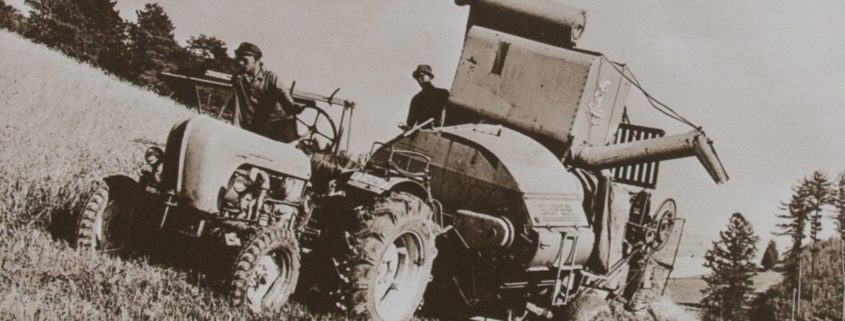Ferdinand Porsche and his tractors
From the „Daimler horse“ to the „System Porsche“ diesel tractor
As a „universal technical genius“, Ferdinand Porsche addressed not only the development of sports cars, but all mechanical constructions for locomotion. Thus, he also played a major role in the motorisation of agriculture.
Porsche developed the so-called „Daimler horse“ for Austro-Daimler right after the beginning of the First World War, in 1914/15 – a powerful prime mover, which should first replace overburdened horses in pulling the otherwise horse-drawn guns (mainly in Galicia). After the end of the war in 1918, these first tractors with 25 hp were used for the pulling of multi-share plows.
In 1938, the development and construction of some prototypes of the „Volkstractor“ began – Porsche´s vision to increase agricultural yields, safeguard food supply and relieve the workforce and draft animals. Likewise, the tractor should help to remove existing bottlenecks in the cultivation of agricultural land. The project was funded by the German Labor Front (DAF), whose head Dr. Ley – a confidant of Hitler – wanted to build one of Europe’s largest tractor factories in Waldbröl. In contrast to the price of 1,200 Reichsmark for a good team of horses, the tractor should cost no more than 1,000 Reichsmark. Ferdinand Porsche used the project to realise his own three goals: the construction of a sports car, a Volkswagen and a Volkstractor.
With the start of the Second World War in 1939 and the associated fuel shortage, Porsche developed a tractor which could be operated with wood or coke and installed wood gas generators in the Volkstractor.
In 1944, the „Ferdinand Porsche Ing. h.c. Construction“ moved to Gmünd near Villach due to the bombing of Stuttgart. With master engineer, Karl Rabe, work on a wood gas fuel inline two-cylinder motor for Type 113 began. Until 1945/46, there were only around 67,000 tractors in Austria and Germany. Only about 2,000 tractors were produced each year, because during the war the focus lay on so-called „defense technology“ machines.
After the war, in 1946, around 300 employees worked in Gmünd. Until 1948, no tractors were produced (due to a lack of resources), but cable winches for agriculture and forestry, cableways, small hydroelectric turbines, small wind turbines with generators, mountaineering equipment made of metal alloys, ski bindings and the like.
In 1948, Porsche and his team were finally able to design the long-planned Volkstractor based on model 313. A license agreement was concluded with the Allgaier Tool Construction Company in Uhingen in 1949 and, in 1950, the universally applicable AP 17-1 18 hp tractor was presented to the public at the German Agricultural Society Trade Fair in Frankfurt. The many technical innovations such as air cooling, light-weight construction, oil-hydraulic coupling and the unrivaled acquisition price of 4,450 DM led to the delivery of 1,550 bright orange and only 950 kg „System Porsches“ by the end of 1950. From 1951 followed a successor – the AP17- 2 with more power (22 hp) and an ergonomically designed steering wheel.
From 1953 to 1955 Allgaier also launched a new series of green tractors: the A111 to A144 (11-44 hp). At the end of 1955, however, Allgaier ended the production of tractors due to excessive investment costs for production expansion.
In 1956, Allgaier Machine Construction was transformed into Porsche Diesel Motor Construction Friedrichshafen and developed a crimson tractor series with the types names Junior, Standard, Super and Master. Around 120,000 Porsche diesel tractors were built in eight years until 1963. Despite successful sales figures, tractor construction was stopped at the end of 1963 due to strong competition.
Even today, Allgaier and Porsche diesel tractors are highly popular to tractor fans. Visit the Traktor-Stadl tractor barn at fahr(T)raum Mattsee and see our large collection of historical tractors for yourself!
Further related article „A Porsche tractor for Brasil – the P312„.






